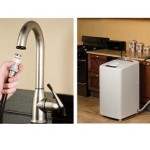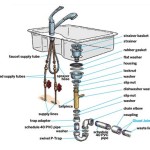The Rise of Kitchen Sink Foaming Soap Dispensers: Convenience and Efficiency
The kitchen sink foaming soap dispenser has become an increasingly popular addition to modern kitchens. This seemingly simple device offers a number of benefits over traditional liquid soap dispensers, primarily centered around efficiency, cost-effectiveness, and hygiene. Its integration into the kitchen environment often enhances both functionality and aesthetic appeal. Understanding the mechanics, advantages, and variety of options available is crucial for consumers seeking to upgrade their kitchen setup.
The core function of a kitchen sink foaming soap dispenser revolves around generating foam from liquid soap. This process is not merely diluting the soap with water; it involves a specific mechanism integrated within the dispenser itself. Typically, the dispenser contains a chamber where liquid soap is mixed with air and water in a precise ratio. A pump, either manual or automatic, then forces this mixture through a special nozzle or aerator. This nozzle’s design is essential; it introduces air into the liquid at a high velocity, creating the foamy texture. The resulting foam is dispensed directly into the user’s hand or onto a sponge, ready for use.
Different models utilize varying pumping mechanisms. Manual dispensers often employ a simple push-down or lever-action pump, while automatic dispensers rely on electronic sensors to detect the presence of a hand and activate a motorized pump. The former is more economical and requires no batteries, while the latter offers a hands-free experience, further enhancing hygiene and convenience. The choice between these options largely depends on individual preferences and budget considerations.
Enhanced Soap Efficiency and Cost Savings
One of the most significant advantages of a foaming soap dispenser lies in its ability to significantly reduce soap consumption. Because the liquid soap is pre-diluted with air and water to create foam, considerably less soap is needed to achieve the same cleaning power as its concentrated liquid counterpart. This dilution process is typically calibrated by the dispenser to achieve optimal performance, ensuring effective cleaning while minimizing waste.
The reduced soap consumption translates directly into cost savings over time. A single refill of liquid soap can last considerably longer when used in a foaming dispenser compared to a traditional dispenser. This is particularly beneficial for households with high usage, such as those with large families or frequent entertaining. The savings can accumulate significantly over months and years, making the initial investment in a foaming dispenser a financially sound decision.
Furthermore, refill options for foaming soap dispensers are often more economical than purchasing individual bottles of liquid soap. Bulk refills are readily available, further reducing the cost per wash. This allows consumers to purchase soap refills in larger quantities, often at a discounted rate, thereby maximizing their savings.
The environmental impact of reduced soap consumption should also be considered. By using less soap, the amount of chemicals entering the wastewater system is decreased. This contributes to a more sustainable lifestyle and reduces the strain on water treatment facilities. The compounded effect of widespread adoption of foaming soap dispensers can have a positive impact on the environment.
Improved Hygiene and Reduced Contamination Risk
The hands-free operation offered by automatic kitchen sink foaming soap dispensers significantly enhances hygiene in the kitchen. By eliminating the need to touch the dispenser, the risk of cross-contamination from hands to the dispenser and then subsequently to other users is minimized. This is particularly important in environments where hygiene is of paramount concern, such as households with young children or individuals with compromised immune systems.
The enclosed design of most foaming soap dispensers also helps to protect the soap from external contaminants. Unlike open soap dishes or partially sealed liquid soap bottles, the dispenser prevents dust, bacteria, and other particles from entering the soap solution. This ensures that the soap remains clean and effective, reducing the risk of infection or skin irritation.
Regular cleaning of the dispenser itself is also crucial for maintaining optimal hygiene. However, the design of many foaming soap dispensers facilitates easy cleaning. Removable components, such as the soap reservoir and pump mechanism, can be easily disassembled, washed, and sanitized. This regular maintenance helps to prevent the buildup of bacteria and mold, ensuring that the dispenser remains a hygienic addition to the kitchen.
Furthermore, the foaming action itself can contribute to hygiene. The foam spreads easily and evenly over the hands, ensuring thorough coverage and effective cleaning. This is particularly important for removing stubborn dirt or bacteria from hard-to-reach areas of the hands.
Variety of Styles and Installation Options
Kitchen sink foaming soap dispensers are available in a wide variety of styles and finishes to complement any kitchen décor. From sleek and modern designs to more traditional and ornate options, there is a dispenser to suit every taste and budget. The availability of different materials, such as stainless steel, chrome, brushed nickel, and plastic, further enhances the ability to customize the dispenser to match existing kitchen fixtures and appliances.
In terms of installation, there are typically two main options: countertop dispensers and built-in dispensers. Countertop dispensers are freestanding units that can be easily placed on any countertop surface. They are typically more portable and require no permanent installation. Built-in dispensers, on the other hand, are installed directly into the kitchen sink or countertop. They offer a more seamless and integrated look, but require more effort to install and may necessitate professional assistance.
The installation process for built-in dispensers usually involves drilling a hole into the sink or countertop and connecting the dispenser to a soap reservoir located underneath the sink. This reservoir can be either refillable or disposable, depending on the model. Proper installation is essential to ensure leak-free operation and prevent damage to the sink or countertop.
In addition to these standard options, there are also wall-mounted foaming soap dispensers available. These are typically used in commercial or public restrooms, but can also be installed in residential kitchens for a space-saving solution. Wall-mounted dispensers are typically more robust and vandal-resistant than countertop dispensers, making them suitable for high-traffic areas.
The choice between these different styles and installation options ultimately depends on individual preferences, kitchen layout, and budget. Consumers should carefully consider their specific needs and requirements before making a purchase.
When selecting a kitchen sink foaming soap dispenser, it is essential to consider the capacity of the soap reservoir. Smaller reservoirs may require more frequent refills, while larger reservoirs can hold more soap but may be less aesthetically appealing. The frequency of refills should be balanced with the overall design and functionality of the dispenser.
Another important factor to consider is the type of soap that can be used in the dispenser. Some dispensers are designed to work with specific types of soap, while others are more versatile. It is important to consult the manufacturer's instructions to ensure that the soap being used is compatible with the dispenser to prevent clogging or damage.
The durability and construction of the dispenser are also crucial considerations. Dispensers made from high-quality materials, such as stainless steel, are typically more durable and resistant to corrosion than those made from plastic. A well-constructed dispenser will last longer and require less maintenance over time.
Finally, it is important to read reviews and compare prices before making a purchase. Online reviews can provide valuable insights into the performance and reliability of different models. Comparing prices from different retailers can help to ensure that you are getting the best possible deal.

Konghyp Foaming Soap Dispenser Foam Hand Refillable For Bathroom Or Kitchen Sink 5 7x2 9 In Bottles Body Wash

Proox Built In Sink Soap Dispenser Or Lotion For Kitchen Brushed Nickel Abs Pump Head Pr I803 Bn

Soap Dispenser Clara Glass Foam Etsy

Making A Foaming Hand Soap With Castile Lisa Bronner

Konghyp Foaming Soap Dispenser Foam Hand Refillable For Bathroom Or Kitchen Sink 5 7x2 9 In Bottles Body Wash

Built In Foaming Soap Dispenser Counter Mounted For Kitchen Sinks Brushed Nickel Oil Bronze

Foaming Soap Dispenser Set Farmhouse Kitchen Sink White Jars Etsy

Oxo Stainless Steel Foaming Soap Dispenser Berings

Full Circle Foaming Soap Dispenser The Container

Kitchen Sink Soap Dispenser Lotion Sanitizer Dispensers Wall Mount Foaming Foam Made In China Com







